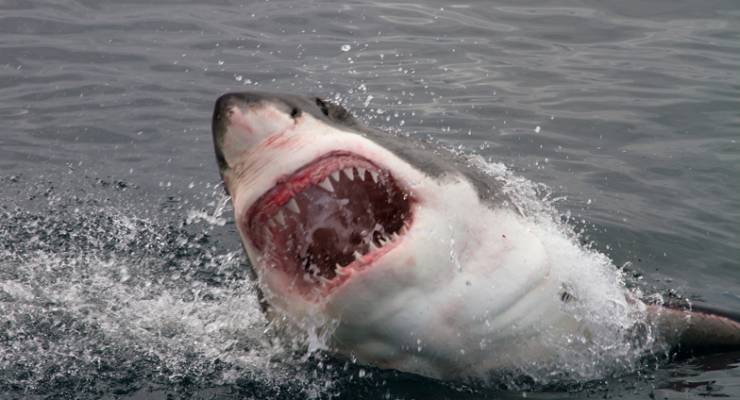
The recent deaths of surfer Ben Gerring and diver Doreen Collyer last week have brought the issues around shark hazard management in Western Australia back to the surface. The front page of Wednesday’s West Australian, a Jaws-style Photoshop job, indicates the level of emotion attached to what is a messy and inconclusive debate.
What’s WA’s policy on shark attacks?
Currently, the Department of Fisheries can issue an order to have a shark destroyed using baited drum lines if it poses a “serious risk” to the public. This policy was used to justify the catching and killing of a 4.2-metre great white shark the day after Gerring was bitten. Despite Fisheries spokesman Tony Cappelluti admitting “you can never be entirely certain that it’s the same shark” at a press conference on Monday, a similar operation has been set up off Mindarie near the site of the attack on Collyer.
At the same press conference, Premier Colin Barnett reiterated the commitment to destroying “high-risk” sharks, saying: “If there is an imminent threat to the public from a shark, we reserve the right to destroy that shark.”
What was in place before the ‘high risk’ policy?
WA Fisheries has always had some version of this power. However, in 2014 the WA state government commenced a 13-week trial of a shark “cull” policy, following seven fatal attacks between 2010 and 2013. Barnett was defiant in the face of criticism at the time, telling The Weekend West:
“It’s very easy to criticise a policy like that, it’s very easy to say the solution is in research or education … that doesn’t deal with the situation.
“As Premier, I have no alternative but to react to seven deaths in three years and people scared to go to the beach. I have a responsibility to act in (the name of) public safety .”
However, the program, which killed 68 sharks (none of which were great whites) using baited drum lines, was hugely unpopular with the public and shark experts. Following a recommendation by the Environmental Protection Authority, it was ditched in September of that year. The policy then shifted to individual sharks, with Barnett telling reporters “our focus will be now what do you do with perhaps a rogue shark that stays in the area and is an imminent threat to beachgoers, and I think that shark has to be destroyed and moved”.
What is a rogue shark exactly?
Associate Professor Nathan Hart from the department of biological sciences at Macquarie University says there is no evidence to suggest that “rogue” or “high-risk” sharks exist.
“There is no published data, that I’m aware of, on repeat attacks, so the science just isn’t there,” he told Crikey.
“It’s almost impossible to determine for sure whether a shark is the same one that was responsible for an attack — you’re often relying on first-hand accounts from people with visibility issues looking through water, so it’s hard even identifying what species of shark it is, let alone an individual shark.”
Indeed, even the WA state government’s own Sharksmart website dismisses the “rogue” idea. It’s FAQ tells us, “A ‘rogue’ shark is one that returns to the same location and deliberately targets humans. Evidence would suggest it’s extremely unlikely that a rogue shark has been involved in any WA shark incidents … It is simply an unsubstantiated theory.”
Hart said sharks’ mobile nature further complicates matters.
“Sharks aren’t highly territorial, like, say crocodiles, so that animal is not likely to just hang around.”
Dr Leah Gibbs, a senior lecturer at the Australian Centre for Cultural Environmental Research at the University of Wollongong, says the policy is the result of “fantasy representations of sharks, not from our understandings of how species behave”.
“Killing a shark does not present a deterrent to other sharks,” she said. “So a policy based on catching and killing individual sharks is a policy based on retribution.”
And culling sharks definitely doesn’t work?
When the policy was initially put in place, 301 marine and environmental scientists signed a submission to the review of Western Australian shark policy opposing the cull. However, a similar policy has been in place in Queensland, with relatively little protest, for decades.
“Shark control equipment [drum lines and nets] is in place off 85 beaches throughout Queensland to reduce the possibility of shark attack for swimmers,” a Fisheries Queensland spokesperson told Crikey.
“The Queensland Shark Control Program’s use of drum lines and shark nets is effective in reducing the overall number of sharks in an area, making it a safer place to swim. Since the start of the program in 1962, there has been one shark fatality at a shark control beach in Queensland.”
Gibbs conducted research into the public response to the introduction of the culling policy in WA and concluded that the majority of ocean users opposed it. But the killing in the aftermath of the Gerring attack has attracted little condemnation, and Barnett hinted in yesterday’s Australian that the public might be re-thinking opposition to a catch and kill policy.
“It is always hard to say what triggers public response,” Gibbs said, adding that people might be getting used to the idea of killing sharks.
“The large protests that took place in 2014 in WA, across Australia and around the world were a response to a newly introduced policy. They marked a dramatic shift from the previous policy approach.”
So what purpose does the policy actually serve?
Hart thinks, ultimately, the current policy in Western Australia is simply political.
“The government has to be seen to be doing something, which I understand, if it was my child who had been bitten, I’d want to know something was being done,” he said. “But from a purely dispassionate distance, it’s probably not going to make anyone safer.”
So what will make people safer?
Part of the difficulty facing the WA government in developing an appropriate response is the simple lack of hard knowledge around what causes shark attacks, and what can be done to prevent them. A May 2016 report from the WA Department of Fisheries makes a series of concessions of that nature, stating:
“In lieu of reliable scientific evidence to explain these rare and unpredictable interactions, there has been considerable speculation about the possible causes of white shark encounters and attacks around the State and many theories and opinions have instead gained popular acceptance.”
Further, the report says it’s difficult to directly compare the effectiveness of risk management strategies centred on “control (generally large-mesh gill-net and drum-line fishing), deterrence (e.g. electric, visual, chemical), exclusion (barriers, shark re-location) and monitoring” because of the variation in the objectives, target species, location, scale and duration between different programs.
Perhaps significantly, the report makes no comment on the effectiveness of killing individual sharks in response to attacks, and only refers to WA’s “cull” period in its capacity as a monitoring exercise.








There are probably more “sharks”walking the streets.
And definitely in the banking and finance sectors. No culling proposals either.
BillH – they’d be easier to cull, just bait the drum lines with $100 bills.
One of the things I have yet to see discussed is: Are we seeing any greater frequency of shark attacks in recent years? Certainly the risk of being killed by a shark would be much lower than all sorts of things. I had a quick look at the ABS “causes of death” for all of Australia, 2014. “Contact with a marine animal” 3 deaths. “Fall involving bed” 43 deaths. So I guess it is a bit early to start theorising as to whether sharks are getting more hungry due to (fill in your favorite environmental cause).
Water is the natural habitat of sharks. The land is the natural habitat of humans. If we choose to intrude upon their habitat we do so at our own risk.